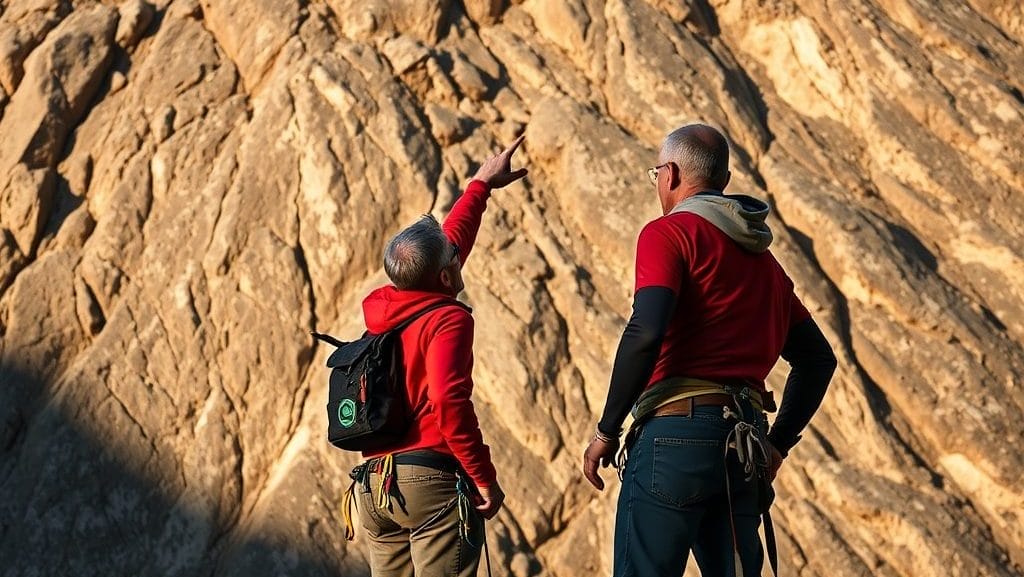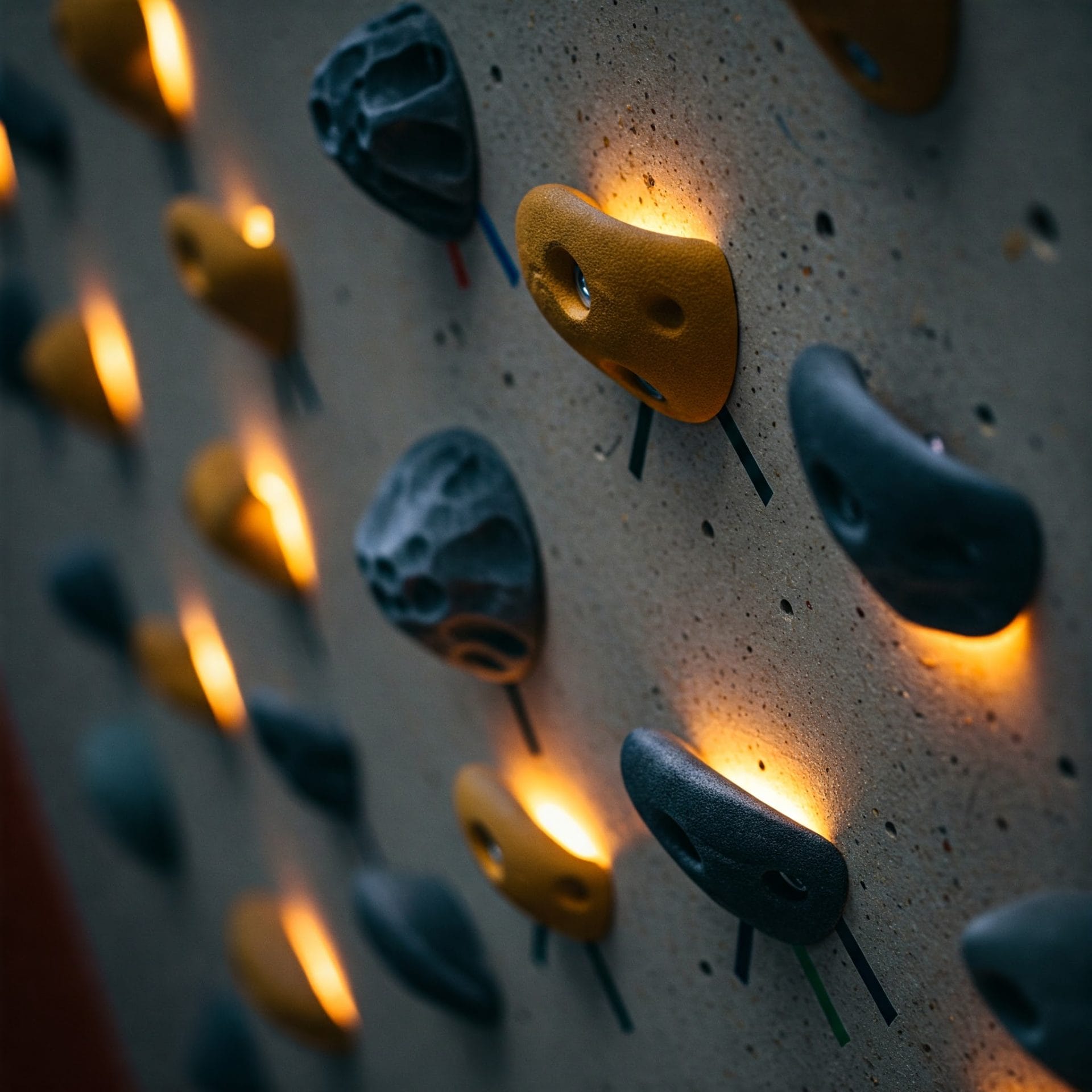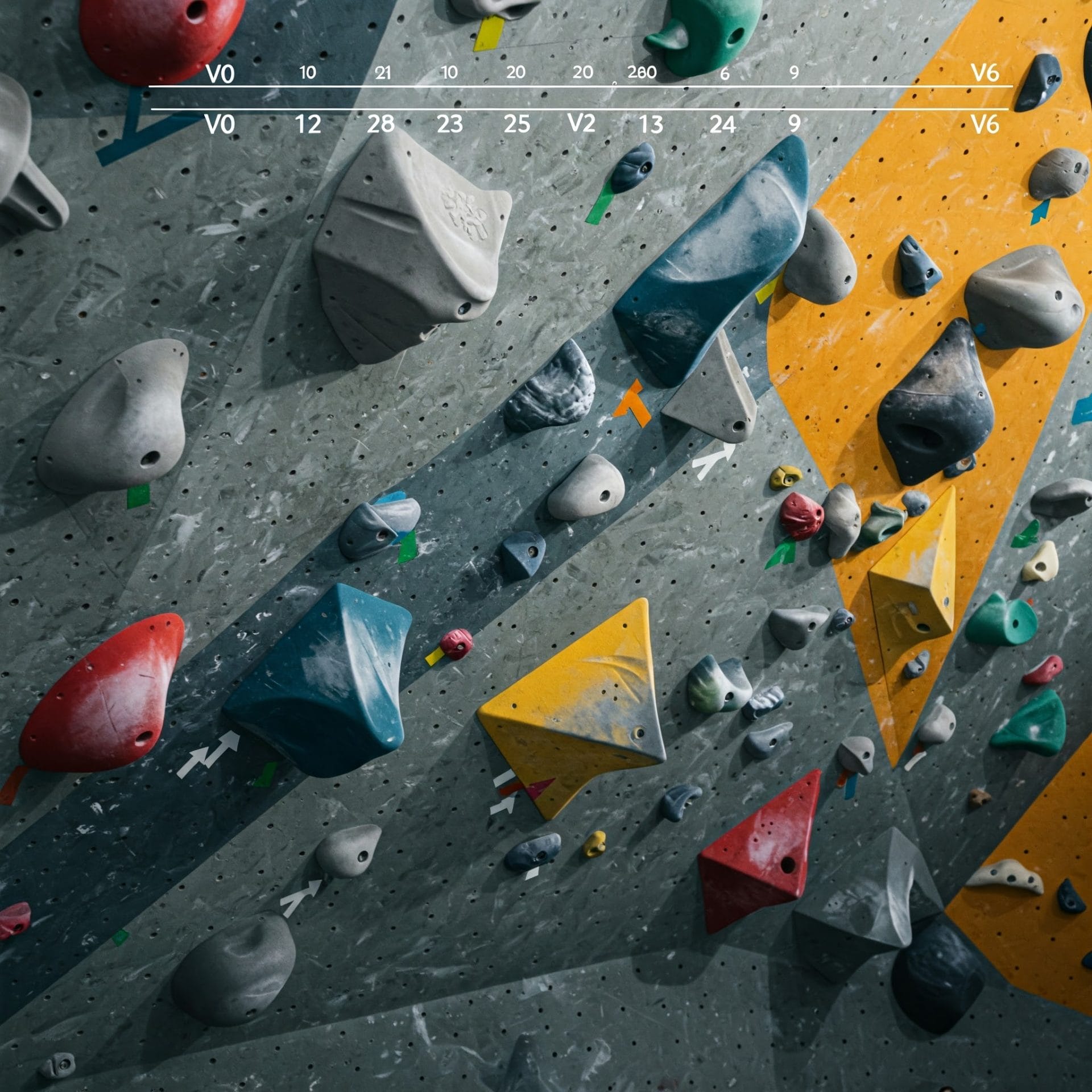Learn all about climbing terms and slang that help you understand this exciting sport!
Rock climbing and bouldering come with specific terms that climbers need to know. From essential safety words like “belayer” (the person controlling the safety rope) to movement-based terms such as “crux” (the hardest part of a climb), these phrases form the basic language of climbing.
Understanding this vocabulary helps climbers communicate effectively at the crag or gym, making the sport safer and more enjoyable. Common terms include:
- Beta: Information about how to climb a route
- Send: Successfully completing a climb
- Dyno: A dynamic jumping move
- Spotting: Protecting a climber from falls
Keep reading to master more climbing terms.(1)
Key Takeaway
- Climbing has many unique terms that help climbers communicate.
- Knowing climbing terminology can make your climbing experience safer and more fun.
- Understanding these words can help you learn new techniques and improve your skills.
Understanding Climbing Terminology
Climbing is a demanding sport that requires not only physical strength but also a deep understanding of the lingo. Here are some key terms:
- Belayer – The person managing the rope and ensuring the climber doesn’t fall too far.
- Crux – The hardest part of the climb, where skills and endurance are tested.
- Fall Factor – The severity of a fall, based on the distance fallen and slack in the rope.
- Beta – Advice or tips for a specific climb.
- Onsight – Completing a route on the first try without prior knowledge.
- Lead Climbing – Climbing with protection gear placed along the way.
- Boulder Problem – A short, intense climb usually done without ropes.
Climbers also mix medical knowledge with their experience, like recognizing a “tweaked ankle” or “sprained finger” and knowing how to handle it. Understanding these terms is vital for safety and survival in climbing.
General Climbing Terms
Credit:By Bouldering Bobat
There are many basic terms in climbing that everyone should know. Here are some of them:
- Abseil: This is when you come down a rock using a rope. It’s called rappelling in some places.
- Belayer: The person who manages the rope while someone climbs. They help keep the climber safe.
- Carabiner: This is a metal hook that connects ropes to anchors. They help keep everything secure.
- Chalk: Climbers often use chalk to keep their hands dry. It helps them grip better.
- Climbing Area: This is just a place where you can go climbing. It has many different routes to try.
Knowing these terms helps climbers talk to each other and stay safe. If you’re at a climbing gym or outside, you’ll hear these words a lot!(2)
Techniques and Moves in Climbing

Climbing isn’t just about going up rocks; it’s also about how you do it! Here are some important moves and techniques:
- Beta: This is advice about a route. It can be tips on how to climb better or find holds.
- Crux: The hardest part of a climb. Climbers often talk about the crux when they describe how tough a route is.
- Sus: To “sus” means to check out a climbing problem. It’s when you look at the route before you start climbing.
- Crimp: A small ledge that requires a tight grip. You have to use your fingers just right to hold on.
These moves and techniques are important for climbing safely and efficiently. When you understand terms like crux and beta, you can climb better and have more fun!
Types of Climbing
Bouldering
- Bouldering feels like a raw, unspoken conversation with the rock.
- You climb without ropes or harnesses, relying solely on your body.
- The boulders are under 15 feet tall, but the challenge is real.
- You’ll push, stretch, and search for the right hold, often slipping or losing footholds.
- Mental focus is key, and the body tires quickly.
- Common terms include “mantle” (getting over a ledge) and “crux” (the hardest part).
- Though quick, bouldering is mentally demanding and exhilarating.
Caving
- Caving involves squeezing through tight spaces beneath the surface.
- It’s dark, silent, and eerie, requiring headlamps and sturdy gear.
- Some caves have impressive stalactites and stalagmites, while others are tight and claustrophobic.
- Movement is slow, and discomfort is part of the adventure.
Traditional Climbing
- Traditional climbing requires placing your own safety gear as you go.
- It’s a balance of skill, trust, and decision-making.
- You must trust your gear, body, and judgment, especially in exposed areas.
- The climb is slow, deliberate, and rewarding with patience.
The Importance of Climbing Terminology
Climbing terminology isn’t just about impressing others. It’s essential for clear communication, safety, and learning. Without it, you might miss crucial advice.
- Crux: The hardest part of a climb, where you’re most likely to struggle or succeed.
- Send: Completing a climb without falling or resting on the rope.
- Mantle: A move where you press down with your hands and lift yourself onto a ledge.
- Boulder problem: A short, tough route you climb without ropes, focused on strength and technique.
Understanding these terms is vital. When climbers use this language, they’re creating a shared understanding. You can prevent injuries by knowing what others mean. Plus, it helps build confidence and connections. When everyone speaks the same language, you become part of the climbing community. It’s not just about sounding smart—it’s about improving and staying safe.
Practical Advice for Learning Climbing Terms
Climbing is full of unique terms that may leave you confused at first, but don’t worry—everyone has been there. Here are some tips to help you learn the language:
- Ask Questions: If you’re unsure of a term, ask! Climbers love to share their knowledge.
- Practice: The more you climb, the more terms you’ll learn naturally. Start using them on the wall.
- Use a Dictionary: When a term stumps you, look it up in a climbing-specific dictionary.
As you practice, terms like “crux” and “beta” will become second nature. You don’t have to master everything at once—small steps and repetition will help. Keep asking, practicing, and learning from others, and soon you’ll feel fluent in climbing lingo.
Conclusion
Climbing terms serve as building blocks for safety and communication in rock climbing. A belayer manages the rope system, while the crux marks the hardest part of a climbing route. These basic terms (along with proper technique) create a foundation for both indoor gym sessions and outdoor climbing. Learning this specific vocabulary helps climbers discuss routes, share beta, and maintain safety protocols during each climb.
FAQ
What is climbing terminology?
Climbing terminology refers to the specific words and phrases used in the climbing community. These terms help climbers communicate clearly about techniques, equipment, and safety measures. Understanding this language can make climbing safer and more enjoyable, especially for beginners.
What does “bouldering” mean?
Bouldering is a style of climbing performed on short, yet challenging rock formations or artificial walls, usually without ropes. Climbers use crash pads to protect themselves from falls. It’s more about strength and technique than endurance since the climbs are typically shorter.
What are “carabiners”?
Carabiners are metal loops with a spring-loaded gate, used in climbing to connect ropes, harnesses, and other gear. They come in various shapes and sizes, each designed for specific purposes. Knowing how to use them correctly is super important for safety.
What is a “crux”?
The crux is the hardest part of a climbing route. It often requires special techniques or strength to overcome. Climbers usually focus on this section, as it can make or break their ascent. Knowing where the crux is can help climbers prepare mentally and physically.
What does “on-sight” mean in climbing?
On-sight climbing means successfully climbing a route on the first attempt without any prior knowledge of it. Climbers usually don’t practice the route or receive any hints about it. This term is often used to measure skill and experience in climbing.
What is a “belayer”?
A belayer is the person responsible for managing the rope while a climber ascends. They use a belay device to control the rope and catch falls. A good belayer is crucial for a climber’s safety, so trust and communication between climber and belayer are key.
What does “top-rope” mean?
Top-rope climbing involves a rope that runs from a belayer at the bottom, through an anchor at the top of the route, and back down to the climber. This setup keeps the climber safe from falls, as the rope is always taut. It’s a popular choice for beginners.
What is a “crash pad”?
A crash pad is a thick foam pad used in bouldering to cushion falls. Climbers place these pads under the climbing area to protect themselves from injury. They come in different sizes and shapes, offering various levels of protection depending on the height of the climb.
References
- https://preply.com/en/blog/climbing-vocabulary/
- https://www.verticalendeavors.com/climbing-terminology/






